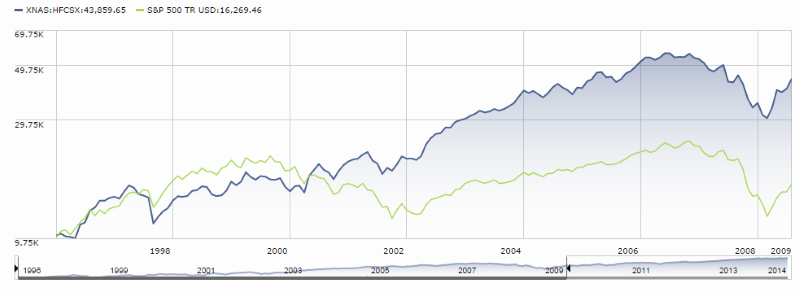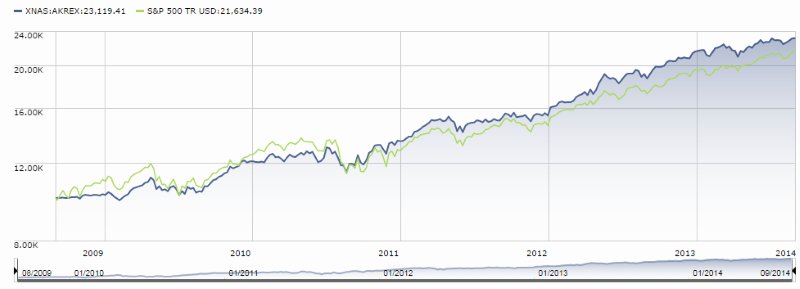Objective
The fund seeks long-term capital appreciation by investing, mostly, in US stocks of various sizes and in “other equity-like instruments.” The manager looks for companies with good management teams (those with “a history of treating public shareholders like partners”), little reliance on debt markets and above-average returns on equity. Once they find such companies, they wait until the stock sells at a discount to “a conservative estimate of the company’s intrinsic value.” The Fund is non-diversified, with both a compact portfolio (30 or so names) and a willingness to put a lot of money (often three or four times more than a “neutral weighting” would suggest) in a few sectors.
Adviser
Akre Capital Management, LLC, an independent Registered Investment Advisor located in Middleburg, VA. Mr. Akre, the founder of the firm, has been managing portfolios since 1986. As of June 30, 2014, ACM had approximately $3.8 billion in client assets under management, split between Akre Capital Management, which handles the firm’s separately managed accounts ($1 million minimum), a couple hedge funds, and Akre Focus Fund.
Managers
John Neff and Chris Cerrone.
Mr. Neff is a Partner at Akre Capital Management and has served as portfolio manager of the fund since August 2014, initially with founder Chuck Akre. Before joining Akre, he served for 10 years as an equity analyst at William Blair & Company. Mr. Cerrone is a Partner at Akre Capital Management and has served as portfolio manager of the fund since January 2020. Before that he served as an equity analyst for Goldman Sachs for two years.
Strategy capacity and closure
Mr. Akre allows that there “might be” a strategy limit. The problem, he reports, is that “Every time I answer that question, I’ve been proven to be incorrect. In 1986, I was running my private partnership and, if you’d asked me then, I would have said ‘a couple hundred million, tops.’” As is, he and his team are “consumed with producing outcomes that are above average. If no opportunities to do that, we will close the fund.”
Active share
96. “Active share” measures the degree to which a fund’s portfolio differs from the holdings of its benchmark portfolio. High active share indicates management which is providing a portfolio that is substantially different from, and independent of, the index. An active share of zero indicates perfect overlap with the index, 100 indicates perfect independence. The active share for the Akre Focus Fund is 96, which reflects a very high level of independence from its benchmark S&P 500.
Management’s Stake in the Fund
Mr. Neff and Mr. Cerrone have each invested over $1 million of their own money in Akre Focus.
Opening date
August 31, 2009 though the FBR Focus fund, which Mr. Akre managed in the same style, launched on December 31, 1996.
Minimum investment
$2,000 for regular accounts, $1000 for IRAs and accounts set up with automatic investing plans. The fund also has an institutional share (AKRIX) class with a $250,000 minimum.
Expense ratio
1.3% on assets of about $4.2 billion, as of June 2023. There’s also a 1.00% redemption fee on shares held less than 30 days. The institutional share class on assets of about $7.2 billion has an expense ratio of 1.04% with the difference being the absence of a 12(b)1 fee.
Comments
In 1997, Mr. Akre became of founding manager of FBR Small Cap Growth – Value fund, which became FBR Small Cap Value, then FBR Small Cap, and finally FBR Focus (FBRVX). Across the years and despite many names, he applied the same investment strategy that now drives Akre Focus. Here’s his description of the process:
-
We look for companies with a history of above average return on owner’s capital and, in our assessment, the ability to continue delivering above average returns going forward.
Investors who want returns that are better than average need to invest in businesses that are better than average. This is the pond we seek to fish in.
-
We insist on investing only with firms whose management has demonstrated an acute focus on acting in the best interest of all shareholders.
Managers must demonstrate expertise in managing the business through various economic conditions, and we evaluate what they do, say and write for demonstrations of integrity and acting in the interest of shareholders.
-
We strive to find businesses that, through the nature of the business or skill of the manager, present clear opportunities for reinvestment in the business that will deliver above average returns on those investments.
Whether looking at competitors, suppliers, industry specialists or management, we assess the future prospects for business growth and seek out firms that have clear paths to continued success.
The final stage of our investment selection process is to apply a valuation overlay…
Mr. Akre’s discipline leads to four distinguishing characteristics of his fund’s portfolio:
- It tends to have a lot of exposure to smaller cap stocks. His explanation of that bias is straightforward: “that’s where the growth is.”
- It tends to make concentrated bets. He’s had as much as a third of the portfolio in just two industries (gaming and entertainment) and his sector weightings are dramatically different from those of his peers or the S&P500.
- It tends to stick with its investments. Having chosen carefully, Mr. Akre tends to wait patiently for an investment to pay off. In the past 15 years his turnover rate never exceeded 25% and is sometimes in the single digits.
- It tends to have huge cash reserves when the market is making Mr. Akre queasy. From 2001 – 04, FBRVX’s portfolio averaged 33.5% cash – and crushed the competition. It was in the top 2% of its peer group in three of those four years and well above average in the fourth year. At the end of 2009, AKREX was 65% in cash. By the end of 2010, it was still over 20% in cash.
It’s been a very long time since anyone seriously wondered whether investing with Mr. Akre was a good idea. As a quick snapshot, here’s his record (blue) versus the S&P500 (green) from 1996 – 2009:

And again from 2009 – 2014:

Same pattern: while the fund lags the market from time to time – for as long as 18-24 months on these charts – it beats the market by wide margins in the long term and does so with muted volatility. Over the past three to five years AKREX has, by Morningstar’s calculation, captured only about half of the market’s downside and 80-90% of its upside.
There are two questions going forward: does the firm have a plausible succession plan and can the strategy accommodate its steadily growing asset base? The answers appear to be: yes and so far.
Messrs. Saberhagen and Neff have been promoted from “analyst” to “manager,” which Mr. Akre says just recognizes the responsibilities they’d already been entrusted with. While they were hired as analysts, one from a deep value shop and one from a growth shop, “their role has evolved over the five years. We operate as a group. Each member of the group is valued for their contributions to idea generation, position sizing and so on.” There are, on whole, “very modest distinctions” between the roles played by the three team members. Saberhagen and Neff can, on their own initiative, change the weights of stocks in the portfolio, though adding a new name or closing out a position remains Mr. Akre’s call. He describes himself as “first among equals” and spends a fair amount of his time trying to “minimize the distractions for the others” so they can focus on portfolio management.
The continued success of his former fund, now called Hennessy Focus (HFCSX) and still managed by guys he trained, adds to the confidence one might have in the ultimate success of a post-Akre fund.
The stickier issue might be the fund’s considerable girth. Mr. Akre started as a small cap manager and much of his historic success was driven by his ability to ferret out excellent small cap growth names. A $3.3 billion portfolio concentrated in 30 names simply can’t afford to look at small cap names. He agrees that “at our size, small businesses can’t have a big impact.” Currently only about 3% of the portfolio is invested in four small cap stocks that he bought two to three years ago.
Mr. Akre was, in our conversation, both slightly nostalgic and utterly pragmatic. He recalled cases where he made killings on an undervalued subprime lender or American Tower when it was selling for under $1 a share. It’s now trading near $100. But, “those can’t move the needle and so we’re finding mid and mid-to-large cap names that meet our criteria.” The portfolio is almost evenly split between mid-cap and large cap stocks and sits just at the border between a mid-cap and large cap designation in Morningstar’s system. So far, that’s working.
Bottom Line
This has been a remarkable fund, providing investors with a very reliable “win by not losing” machine that’s been compounding returns for decades. Mr. Akre remains in control and excited and is backed by a strong next generation of leadership. In an increasingly pricey market, it certainly warrants a sensible equity investor’s close attention.
